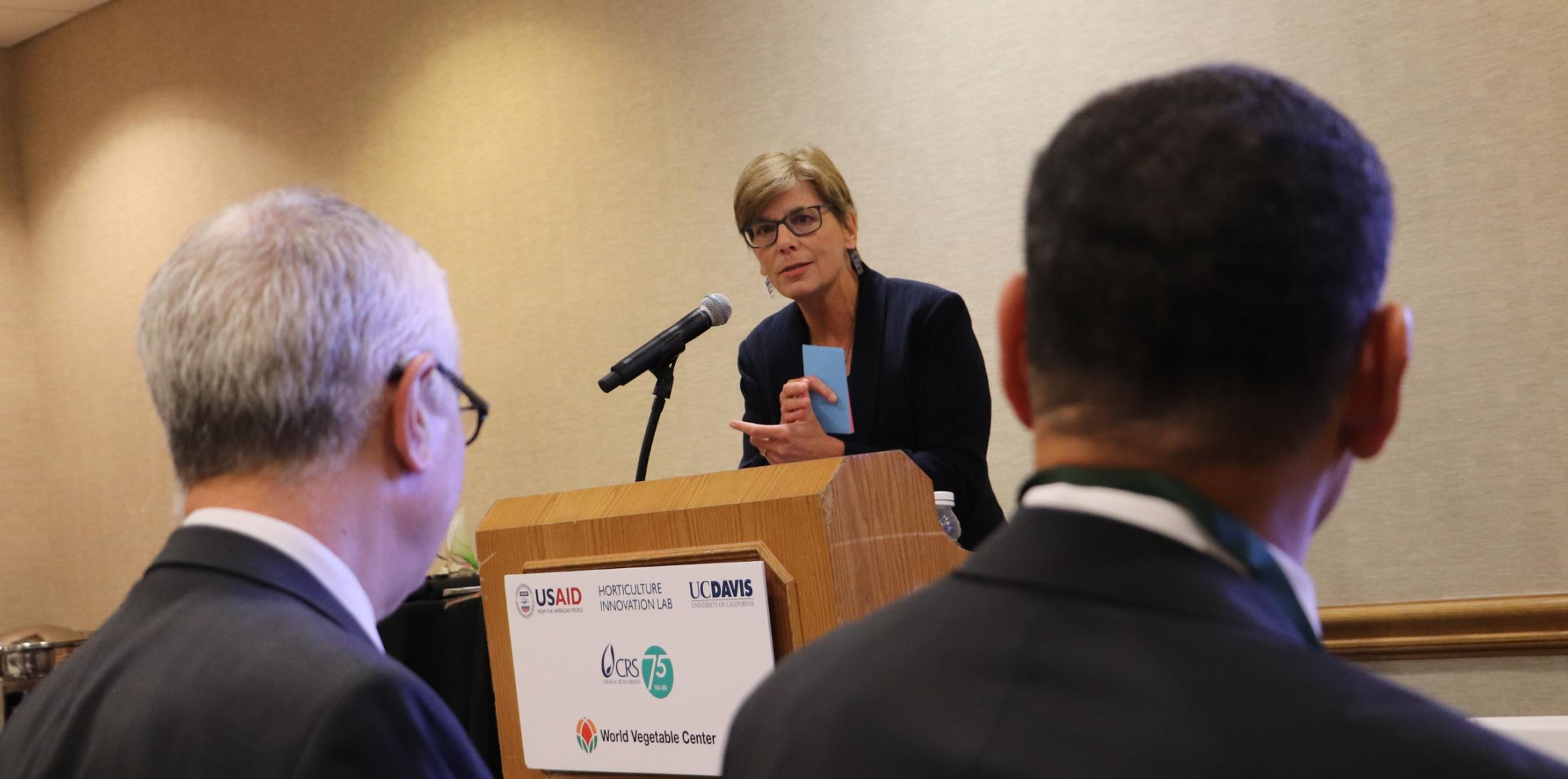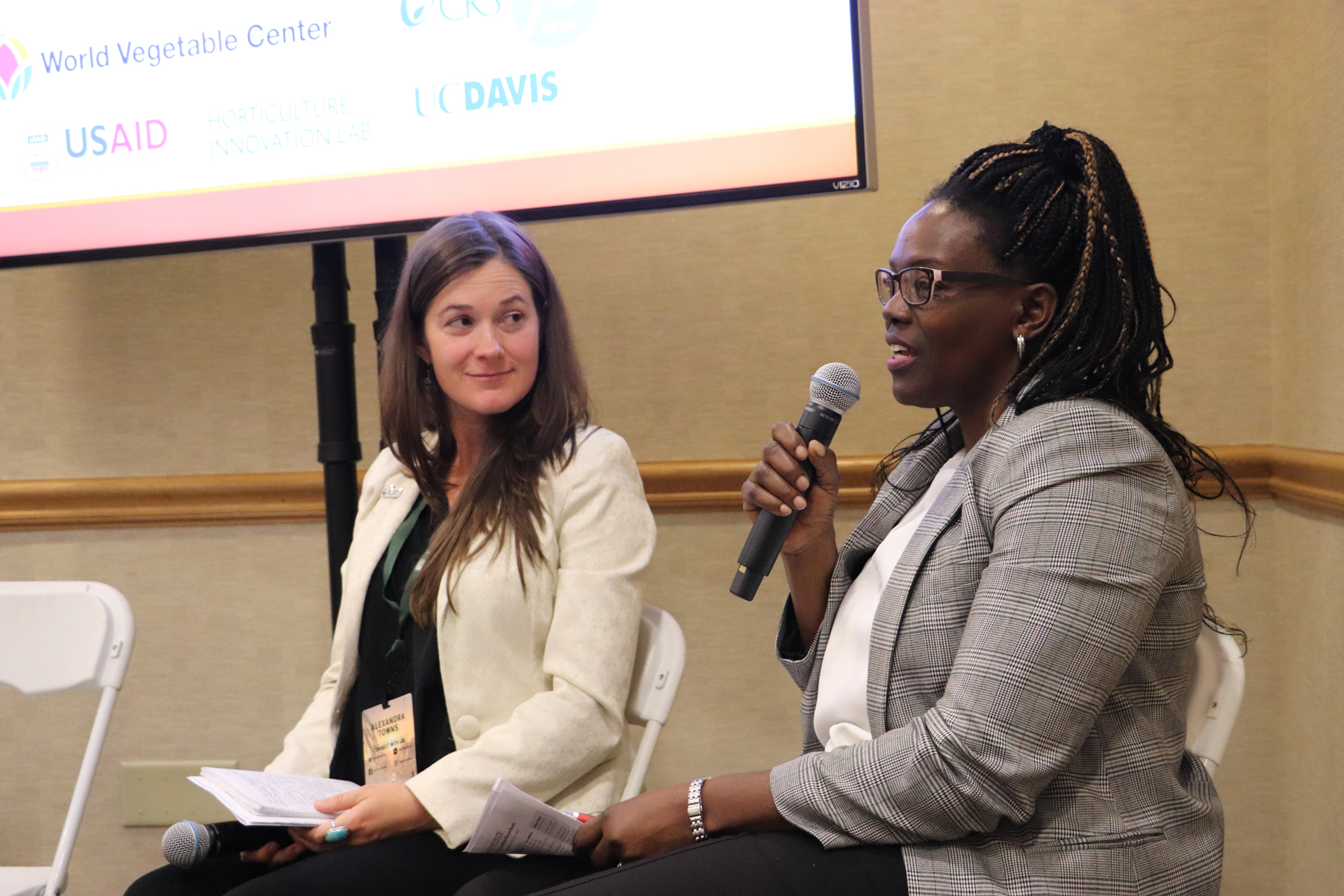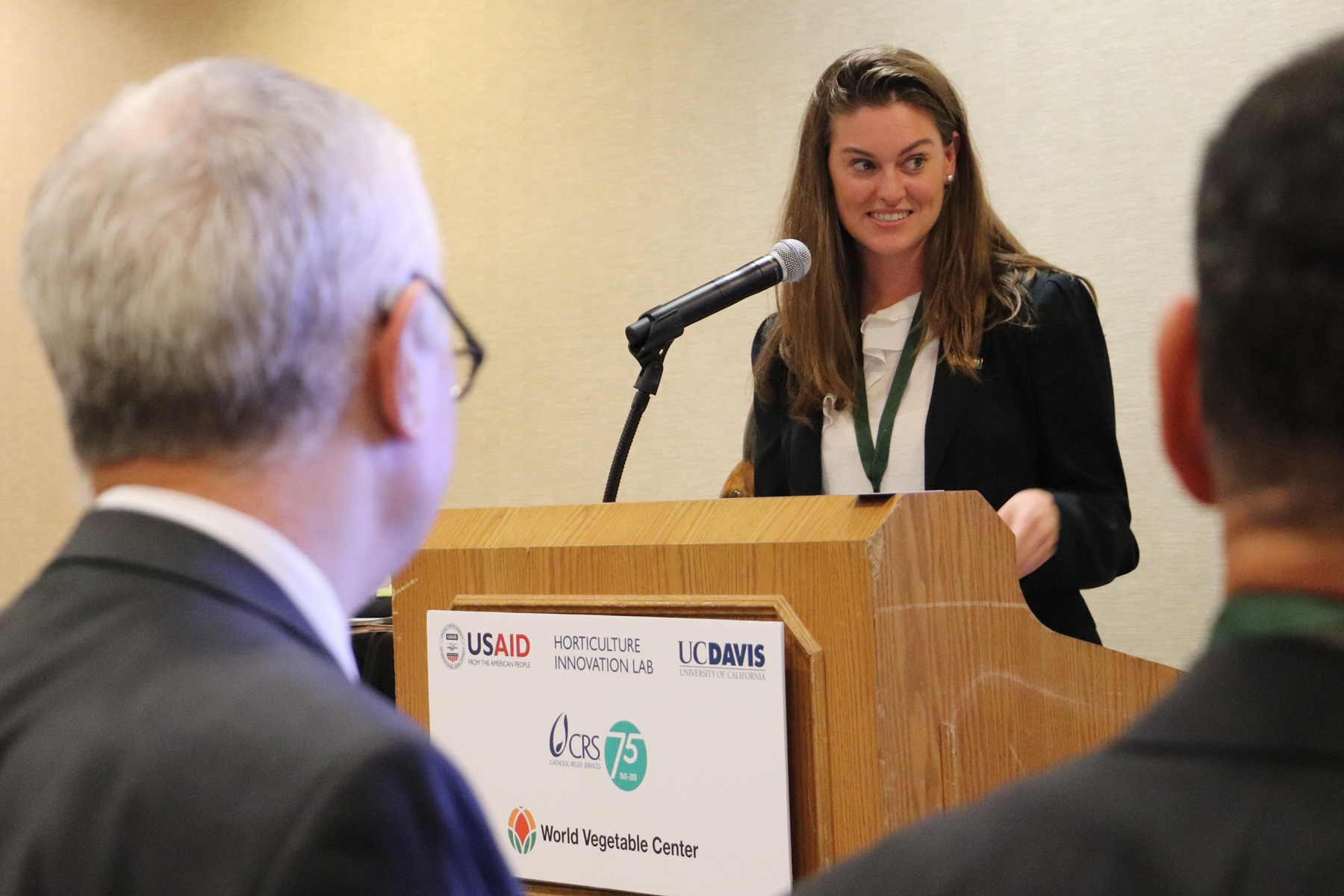
Horticulture Innovation Lab partners with World Vegetable Center, Catholic Relief Services to discuss impacts of horticultural crops
In 2018 the World Food Prize was presented to Lawrence Haddad and David Nabarro for their global leadership in elevating nutrition as a central issue in global food and development agendas. With nutrition thrust into the spotlight at the Borlaug Dialogue International Symposium, the Horticulture Innovation Lab joined with the World Vegetable Center and Catholic Relief Services to co-host a side event focused on the micronutrient and income opportunities of horticultural crops.
“The Power of Produce: How Vegetables and Fruits Can Conquer Malnutrition and Poverty” was held on Oct. 17 in Des Moines, Iowa. A packed room of participants heard from speakers representing the U.S. Agency for International Development, university researchers from multiple Feed the Future Innovation Labs, and leaders from the three co-host organizations.
Increasing fruit and vegetable consumption a ‘must-have’
The moderator for the event, Julie Howard, a World Vegetable Center board member, set the stage by citing recent statistics showing malnutrition affects 1 in 3 people in the world—whether undernutrition, micronutrient deficiencies (“hidden hunger”), or overweight conditions. She also pointed to a recent argument that a rise in obesity in African countries may be related to investments that have been skewed toward cereal grains and animal proteins over the past 50 years, downplaying fruits, vegetables and other nutrient-dense plant foods.
“Our cereal- and animal-heavy diets are having a negative effect on not only human health, but on the environment,” Howard said. “A big push for dietary diversity, including fruits and vegetables, is needed.”
Rob Bertram, chief scientist for USAID’s Bureau for Food Security, called increasing fruit and vegetable consumption “a must-have if we’re serious about reducing malnutrition and poverty.”
He pointed out that appealing to consumers’ aspirations for premium, quality foods is an important strategy.
“Let’s face it, a lot of these foods are attractive on the plate and that makes for a good nutrition outcome when you have a lot of colors on the plate,” Bertram said. “In doing this we can check our poverty reduction box, but also very importantly our nutrition box.”

Leaders on improved vegetable varieties, reducing postharvest losses, youth engagement, private partnerships
From USAID’s Bureau for Food Security, John Bowman moderated a panel on the roles of research organizations and nongovernmental organizations in getting more nutritious produce onto plates. On the panel were Elizabeth Mitcham of the Horticulture Innovation Lab, David Johnson of the World Vegetable Center and Tony Castleman of Catholic Relief Services.
Elizabeth Mitcham discussed the importance of universities in the Horticulture Innovation Lab’s global research network, bringing researchers from U.S. universities together with researchers in developing countries to not only advance horticultural science but to build future capacity for this knowledge-intensive value chain.
“Horticulture is a complex group of crops and even if we solve the problem of today, there will be a new problem tomorrow—and we need those scientists to be able to solve those problems,” Mitcham said.
As a postharvest scientist herself, Mitcham also discussed the problem of food losses after harvest. She said these challenges also represent business opportunities related to equipment and services such as packaging, cold storage, drying, transport and processing.
David Johnson, deputy director general of research for the World Vegetable Center, discussed the program’s plant breeding and genebank activities, including a project that scales vegetable seeds integrated with training in nutrition, water, sanitation and hygiene.
As an agronomist and plant geneticist, Johnson noted that tomato and African eggplant grown in East Africa and Southern Africa showed that about half of the tomatoes grown commercially and 98 percent of the African eggplant were derived from WorldVeg lines.
“Linkage to the private sector is critical,” he explained, in relation to disseminating improved vegetable varieties throughout Africa and Asia. The program leads a vegetable breeding consortium with the Asia Pacific Seed Association and also the African Vegetable Breeding Constorium.
Tony Castleman with Catholic Relief Services discussed the program’s inclusive approach to scaling, including smallholder farmers in particular and a special highlight on young people.
“With horticultural innovations, I want to focus on the role of youth in horticulture, including capacitating and empowering adolescents to become entrepreneurs in horticulture,” he said. “Youth can also be important agents of change in consumption patterns.”
Castleman also discussed CRS activities with homestead gardens, which “can be important tools in nutrition” and require access to seeds, clean water, understanding of household decision making, processing support, and market options. He pointed out that as a development organization, they are carrying out assessments of the right garden type for the specific context, before launching new garden-related activities.

Indigenous vegetables, from traditional knowledge to bioavailability
A panel focused on indigenous vegetables and underutilized foods discussed traditional knowledge, cultural values, nutrient content, dietary diversity, and the potential for expanding markets.
“We know people like these crops and the nutrition is there, but the big challenge we see right now is the frequency of consumption,” said Erin McGuire, panel moderator and associate director of the Horticulture Innovation Lab.
McGuire also shared highlights from the Horticulture Innovation Lab project focused on improving nutrition with African indigenous vegetables in Kenya and Zambia, with researchers from Rutgers, the State University of New Jersey, Purdue University, University of Eldoret, AMPATH Family Preservation Initiative, the World Vegetable Center, and others.
Alexandra Towns, technical advisor for research with CRS, shared her career inspiration from her time as a Peace Corps volunteer in Niger assigned to work with gardening vegetables such as carrots, tomatoes and cucumbers.
“Each day walking home from the gardens, I would see women collecting plants on the side of the road,” Towns explained. Eventually one woman took the time to share information about these plants and brought Towns inside to show her how to cook these indigenous vegetables, and told her to "write this down," which became a mantra for her ongoing work learning from rural women and families about underutilized foods.
She also discussed household seed collection of indigenous vegetable landraces. At one point, Towns interviewed women in a refugee camp and asked if they brought seeds with them.
“They said, ‘Of course we brought our seeds!’” Towns recalled. “They left behind their clothes and other belongings, but they brought along their indigenous vegetable seeds.”
Betty Bugusu, director of the Food Processing Innovation Lab at Purdue University, pointed out that she grew up on a small farm in Kenya, eating the foods discussed by the panel.
“I attribute my health to the African indigenous vegetables that I grew up consuming,” she said.
Bugusu discussed the research her program does related to postharvest handling and processing of indigenous crops, to make these foods more available and accessible. When it comes to processing, her researchers are often focused on how to process so that specific nutrients remain bioavailable—such as Vitamin A in mango.
Bugusu and Towns mentioned that more research is needed related to traditional cooking methods for some African indigenous vegetables, which are typically boiled for long periods or cooked with sodium bicarbonate, both of which can result in reduced nutrients.

Where nutrition research meets policy for fruits and vegetables
The event’s final panel focused on policy related to fruits and vegetables, with Julie Howard moderating a wide-ranging conversation about recent nutrition research findings and potential policy implications with Shibani Ghosh, Associate Director of the Nutrition Innovation Lab at Tufts University.
One recent Nutrition Innovation Lab publication that Ghosh discussed is a price index of nutritious diets, “Measuring the Affordability of Nutritious Diets in Africa: Price Indexes for Diet Diversity and the Cost of Nutrient Adequacy,” led by Will Masters of Tufts University.
Ghosh discussed preliminary findings from various studies in Uganda, Bangladesh and Nepal related to dietary diversity.
In Bangladesh, the Nutrition Innovation Lab is working with the Horticulture Innovation Lab to examine nutrition impacts of agricultural interventions—including three specific horticulture-related technologies and also aquaculture-related practices. She noted that findings so far are showing children under 24 months of age in households that were involved in the agricultural interventions—whether horticulture, aquaculture or both—have better dietary diversity than other surveyed households.

Food safety contamination and aflatoxin issues linked to markets
The Nutrition Innovation Lab researchers generally focus on agriculture, health and nutrition—and a factor Ghosh's team calls “neglected biological mechanisms” which are the “unintended consequences of environmental contamination of poor food safety.”
One such contamination is aflatoxin, a mycotoxin produced by mold in some dried foods. The Nutrition Innovation Lab studied aflatoxin levels of women in Nepal and Uganda and found that 90 percent of all women had evidence of aflatoxin in their blood serum. While the level of aflatoxin varied, the researchers couldn’t identify a single factor about the women’s demographics—such as their socioeconomic status, whether they lived in urban or rural households—that related to the aflatoxin.
“Nothing was explaining the aflatoxin contamination of these women; it was ubiquitous,” Ghosh said. “This aflatoxin contamination is linked to markets, it’s not just what you’re producing, it’s what you are acquiring in the markets. So that’s a very critical point for policymakers to think about: If we want to address environmental contamination, we have to go beyond household practices to markets.”
More information:
- Power of Produce event agenda
- Power of Produce event information
- Horticulture Innovation Lab website
- World Vegetable Center website
- Catholic Relief Service website
